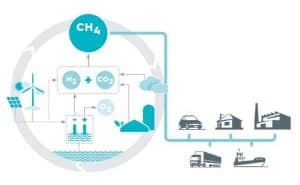
The MethQuest project investigates the creation of methane from renewable sources of energy and its use in stationary systems and vehicles by studying the entire value chain of the gas. This holistic approach promises technological advances in areas that range from production and methods such as electrolysis to the required infrastructure and end use of the gas.
Using renewable methane to advance the transformation of the energy sector is the central aim of researchers working on the MethQuest lead project, launched on Sept. 14, 2018, and funded by the German economy and energy ministry with EUR 19 million. Renewable methane, a sustainable energy carrier, has the advantage that technologies powered by methane are ubiquitous, with millions of devices up and running today. Additionally, the existing pipeline system provides a comprehensive and high-capacity infrastructure to transport, distribute and store the gas and increase the utility of volatile renewable sources of energy.
One focus of MethQuest is transportation. Many vehicles and vessels can, even in the long-term, be powered only by chemical energy carriers. One example is high sea vessels; another is heavy-duty trucks. The benefit of renewable methane is that, compared to alternative liquid fuels, the needed technical procedures are simpler, while the gas can be converted much more efficiently, which has a positive influence on production costs and the demand by renewable energy generation facilities.
Another advantage is the uncomplicated substitution of fossil fuel-based compressed or liquified natural gas, that is, CNG or LNG, by compressed or liquified renewable methane to ensure that existing power plants and engines can be used in the future. As the ratio of renewable methane to fossil gas can be increased gradually, there is no need to change fuels in the short term and appliances will not have to be replaced either.
…
read more in H2-international April 2019

























0 Comments